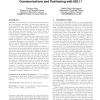281 search results - page 49 / 57 » Peer-to-Peer Application Recognition Based on Signaling Acti... |
TNN
1998
13 years 6 months ago
1998
—Adaptive resonance theory (ART) describes a family of self-organizing neural networks, capable of clustering arbitrary sequences of input patterns into stable recognition codes....
BIBM
2010
IEEE
13 years 4 months ago
2010
IEEE
ATP is a ubiquitous nucleotide that provides energy for cellular activities, catalyzes chemical reactions, and is involved in cellular signaling. The knowledge of the ATPprotein in...
MOBISYS
2008
ACM
14 years 6 months ago
2008
ACM
Using 802.11 concurrently for communications and positioning is problematic, especially if location-based services (e.g., indoor navigation) are concurrently executed with real-ti...
ICRA
2007
IEEE
14 years 1 months ago
2007
IEEE
Abstract— This paper presents a method for detecting independent temporally-persistent motion patterns in image sequences. The result is a description of the dynamic content of a...
ATAL
2005
Springer
14 years 7 days ago
2005
Springer
A directed agent implies an agent with high constraints in both recognition and motion. Because of the embodied restrictions, the directed agent perceives a sense of subjective di...

